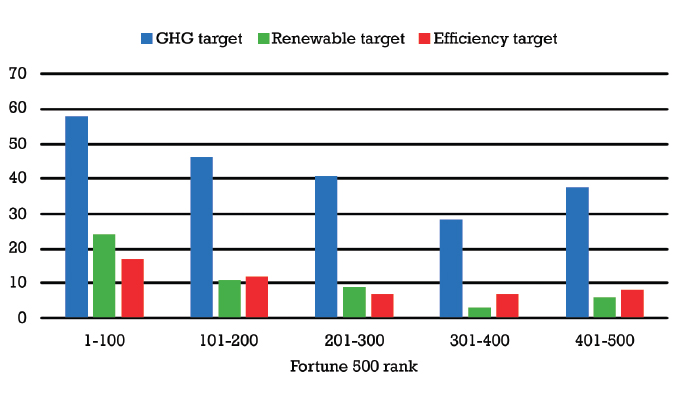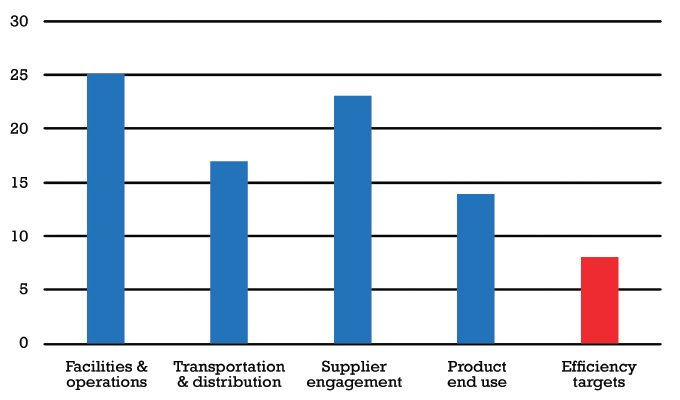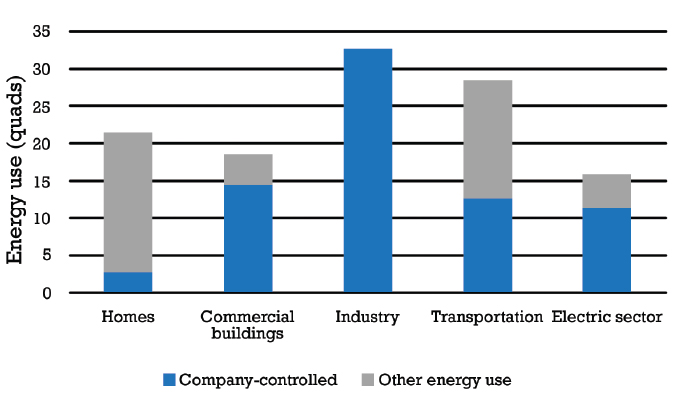By Lowell Ungar and Andrew Whitlock, ACEEE
Many U.S. companies are taking steps to reduce their impact on the environment, and especially on climate change, by undertaking corporate sustainability initiatives. They are trying to address the growing focus on sustainability from investors, customers, governments, and employees. Companies are setting sustainability goals, taking steps to reduce emissions, and reporting progress in sustainability reports and financial disclosures. Energy use and its effect on GHG emissions are a major focus of these initiatives.
Energy efficiency should be the foundation for achieving corporate climate and sustainability goals. Many studies show efficiency is critical to meeting climate goals. The International Energy Agency’s Sustainable Development Scenario gets 44 percent of its carbon reductions in 2040 from energy efficiency. The American Council for an Energy-Efficient Economy (ACEEE) found that efficiency measures could cut U.S. GHG emissions by half in 2050. Companies should use efficiency because it saves them money on their energy bills while yielding large environmental benefits. For example, FedEx has achieved most of its carbon emissions reductions (almost 2 million tons in 2018) from more efficient aircraft and flight operations, while also saving $394 million. United Technologies has found that “efficiency improvements…represent the greatest opportunity for us to reduce our GHG emissions.”
In addition to cutting emissions and saving money on energy bills, energy efficiency measures can often increase productivity and minimize waste by optimizing processes and equipment, and thus can strengthen competitiveness. These measures can improve lighting and air quality and comfort. Efficiency can even help meet renewable energy percentage targets cost effectively by reducing the energy use that must be met from renewable sources.
The first part of this two-part series describes some of the ways energy efficiency can improve corporate sustainability and the scale of potential savings that company efficiency measures could achieve. We discuss current corporate energy efficiency targets, mostly on the basis of a literature review. Efficiency targets are an important way to focus management attention and help efficiency projects compete for capital investments.
Although the statistics and examples in this brief are drawn from large companies, we hope the information and recommendations are useful to smaller companies as well. Small and medium-sized companies have most of the same energy savings opportunities but may have fewer resources to devote to sustainability planning and reporting.
HOW COMPANIES CAN SAVE ENERGY AND REDUCE CARBON EMISSIONS
The GHG Protocol, developed by the World Resources Institute and the World Business Council for Sustainable Development, sets the standard for how most companies measure GHG emissions. It classifies corporate emissions into three scopes:
- Scope 1: Direct emissions from sources the company owns or controls
- Scope 2: Indirect emissions from the generation of electricity the company purchases
- Scope 3: Indirect emissions other than Scope 2 from the value chain of the company, including both upstream and downstream emissions
Companies often start reducing energy use in their offices, warehouses, data centers, manufacturing plants, vehicle fleets, and other operations to save money. Then they expand these efforts to cut Scope 1 emissions (from burning fossil fuels directly) and Scope 2 emissions (from electricity use). Lighting and building retrofits, equipment and vehicle replacement, and industrial process changes improve the efficiency of physical facilities and equipment. Building commissioning, strategic energy management, smart buildings, and smart manufacturing optimize operations and reduce waste. For example, Allstate Corporation set and achieved their efficiency target of reducing the energy used at facilities they own 20 percent by installing LED lights and optimizing energy use for heating and cooling.
Scope 3 emissions are often the largest source of emissions for companies, but they can be harder to address. Some large companies help their suppliers and vendors improve efficiency to reduce costs as well as environmental impacts. Nike has a goal focused on reducing upstream emissions from its purchased goods and services, namely, to reduce the emissions intensity from textile dyeing and finished processes 35 percent from 2015 levels by 2020. Other companies reduce downstream emissions by improving the efficiency of their products. For example, they may make or sell Energy Star® appliances or more-effective products that save energy (e.g., structural insulated panels). Whirlpool, an appliance manufacturer, says it has reduced “lifetime product-in-use emissions” over 50 percent from a 2005 baseline and is now planning to update its goal. Companies also help employees reduce commuting and travel energy use by encouraging public transit and telecommuting.
Some actions to reduce emissions extend beyond Scope 1, 2, or 3 and provide broader system benefits. Companies can advocate effective public policies that promote energy efficiency, support efficiency organizations, educate their customers on how to save energy, contribute employee time to making low-income homes more efficient, or work to strengthen broader community clean-energy efforts.
THE LARGE POTENTIAL IMPACT OF CORPORATE ENERGY SAVINGS
Companies directly control roughly three-fourths of all US energy use and consequent emissions, from apartment buildings and shopping malls to manufacturing plants, power plants, and long-haul trucks, as shown in figure 1. ACEEE estimates that by 2050, U.S. companies collectively could reduce their projected energy use by roughly half and reduce resulting carbon dioxide emissions by more than half. Globally, CDP (formerly the Carbon Disclosure Project) has estimated that fewer than 3,000 companies are responsible for one-fifth of total GHG emissions and that just seventy-five companies are responsible for more than half of that.
While every economic sector has opportunities to increase efficiency, some industries are inherently more energy intensive. A series of Department of Energy (DOE) “bandwidth” studies looked at the range of potential energy savings opportunities in sixteen industrial sectors in the United States and found a combined total of 3.1 quadrillion Btus (quads) in available savings from implementation of current technologies (nearly 20 percent of the combined energy use in the examined industries) and an additional 3.7 quads potential savings from technologies under research and development. For example, they found that current technologies could save 0.77 quads in the chemicals sector, 0.34 quads in the food and beverage sector, and 0.32 quads in water desalination. These savings would represent 24 percent, 27 percent, and 20 percent, respectively, of energy use in these sectors.
Nonindustrial companies also have substantial energy savings opportunities. DOE estimates that commercial buildings overall could save 21 percent of energy use with Energy Star equipment and lighting and 46 percent with the most-efficient available technologies. That does not include most appliances; another DOE report estimates commercial appliances could save 22 percent of their energy use with current technology and 36 percent with emerging technology, accounting for another fifth of total commercial building energy use. The International Council on Clean Transportation estimates potential fuel savings of 50 percent for U.S. tractor–trailer trucks and 31 percent for delivery trucks using existing technologies.
SETTING TARGETS DRIVES RESULTS: ENERGY EFFICIENCY IN CORPORATE SUSTAINABILITY TARGETS
Setting specific targets is often the best way to engage corporate teams to identify and pursue energy savings opportunities, help efficiency projects compete with other opportunities for limited capital investments, ensure management visibility, and promote durable commitment. Well-formulated targets can signal support from top executives and help engineers and financial offices work together.
The most comprehensive research on corporate sustainability targets for U.S. corporations is the series of Power Forward reports from World Wildlife Fund, Ceres, Calvert, and CDP. Using information submitted to CDP, as well as corporate sustainability reports and other sources, they looked at goals for the Fortune 500 companies, the largest U.S. companies by total revenue. More than 200 of the Fortune 500 had GHG targets in 2018. For example, Johnson & Johnson aimed to reduce absolute emissions 80 percent by 2050. Fewer companies, just over 10 percent, had specific energy efficiency targets, as shown in figure 2. One example is Home Depot, which aimed at a 20 percent reduction in energy use at its stores by 2020. The company surpassed the goal in 2017.

However, the report likely understates the number of efficiency targets. Power Forward notes that because of CDP reporting protocols, some targets they record as GHG targets may be for reductions that are solely related to reduced energy use and hence are efficiency targets as well. The Alliance for Industrial Efficiency, in a review of 160 large manufacturing companies in several sectors, found that 43 percent had public energy efficiency targets, including in some companies for which Power Forward had not identified such targets (79 percent had GHG targets and 25 percent had renewables targets). But as described below, efficiency targets appear to be less common in other sectors. Overall, we can conclude that well under half of large companies have energy efficiency targets.
The number and kinds of targets identified in Power Forward vary by company size and sector. In general, larger companies are more likely to have GHG, renewable energy, and energy efficiency goals. Figure 3 shows the disparity across sectors.
According to Power Forward, 72 percent of consumer staples companies in the Fortune 500 have climate or energy sustainability goals, but less than one-third of companies in both the financial and energy sectors have any targets. Energy efficiency targets are most common in the consumer discretionary and industrials sectors, but even in those sectors Power Forward identifies such targets for less than 20 percent of companies. We did not find any clear correlation between the energy or carbon intensity of the sectors and the number of sustainability targets.

Companies can set energy targets after evaluating potential savings in their facilities and, depending on scope, supply chains. Strategic energy management approaches (discussed more below) can help identify major energy uses and options for greater efficiency. If the information is available in useful metrics, some companies also observe the efficiency levels their competitors are achieving. For companies that are adopting “science-based targets,” GHG emissions targets that are aligned with societal goals to hold global warming to less than 1.5 or 2 degrees Celsius, energy targets should conform to those broader targets.
Companies set different kinds of energy efficiency goals that best reflect their business operations and have the most impact for achieving their climate goals. For example, Bank of America owns a significant amount of building space, with over 4,300 branches and many office buildings. It has set a target to reduce energy use 40 percent from 2010 levels and to have 20 percent of its real estate portfolio certified under Leadership in Energy and Environmental Design (LEED) standards by 2020. Companies that own large vehicle fleets may focus on the energy efficiency of those vehicles. FedEx aims to improve the efficiency of the FedEx Express vehicles by 50 percent from a 2005 baseline by 2025. Multiple airlines, including Delta, United, and Southwest, have set goals to improve the fuel efficiency of their aircraft. Walmart has energy efficiency goals for both its facilities and its fleet, and it has implemented goals to reduce the energy use and emissions from its supply chain, which accounts for over 90 percent of its total GHG. Manufacturers may be more inclined to focus their targets on energy intensity (such as energy use per dollar value added) rather than absolute energy use due to the variability of demand and changes that result from mergers and acquisitions. Caterpillar has a goal to reduce its energy intensity 50 percent from a 2006 baseline by 2020.
Even when they do not set specific efficiency goals, companies use energy efficiency to achieve cost savings, emissions reductions, and other goals. PepsiCo does not have an efficiency target but is using efficiency, including of vending and cooler equipment, to help achieve a 20 percent reduction in absolute emissions from 2015 levels across its entire value chain by 2030. In the Johnson Controls Energy Efficiency Indicator surveys of energy and facilities managers around the world, cost reduction was by far the leading driver of energy investments in 2013, but by 2018 GHG reductions and energy security had caught up as reasons, with investor, customer, employee, and government interest not far behind. In the 2019 Corporate Energy and Sustainability Progress Report, GreenBiz Research, and Schneider Electric surveyed 309 energy and sustainability professionals at large corporations around the world. Ninety-three percent of respondents had implemented energy efficiency projects compared to the 63 percent using on- or offsite renewables. Seventy-one percent of respondents said that “energy efficiency projects have delivered the greatest cost savings.” Setting energy efficiency targets would help focus these companies’ efforts to achieve even greater savings and help track their performance.
WHAT GETS MEASURED GETS MANAGED: ENERGY EFFICIENCY IN CORPORATE SUSTAINABILITY REPORTS
Although well under half of companies have energy efficiency targets, many more discuss energy efficiency in the corporate sustainability reports or broader corporate social responsibility (CSR) reports they release to show the public their commitment to sustainability and the public good. Sustainability and CSR reporting can help focus management and investor attention on energy efficiency’s key role in meeting GHG and other corporate sustainability goals.
Corporate sustainability reports (we will use the term to include the discussion of sustainability in CSR reports as well) rarely look the same from industry to industry, business to business, and year to year. They sometimes give efficiency a sidebar or case study and sometimes an entire section.

Some reporting frameworks can provide a level of consistency across reports. Global Reporting Initiative (GRI), an international organization based in Amsterdam, sets standards that are the most common framework for sustainability reporting. Their Standard 302 on energy requires material disclosure of company energy use, outside energy use (analogous to Scope 3 emissions), energy intensity, and energy use reductions due to efficiency. Other companies structure their sustainability reports around the United Nations Sustainable Development Goals (SDGs) to highlight their attention to global themes. Several goals relate to energy efficiency, including affordable and clean energy (Goal 7), sustainable cities and communities (Goal 11), responsible consumption and production (Goal 12), and climate action (Goal 13). But neither GRI nor the SDGs require specific metrics that would gauge progress and enable comparison between companies. Although GRI keeps a database of thousands of reports (not all of which follow its standards), we are unaware of a comprehensive analysis or collection of corporate sustainability reports similar to what Power Forward has done for targets.
This brief undertakes a perhaps less systematic analysis by examining thirty sustainability reports from a variety of Fortune 500 Companies in different industries. All thirty of the reports we reviewed describe energy efficiency actions of some kind. They discuss energy efficiency measures in four major areas:
- The company’s facilities and operations
- Transportation and distribution (by both the company’s own fleet and contractors)
- Supplier engagement
- Product end use
As shown in figure 4, the largest number of the sustainability reports we reviewed discuss the efficiency of the companies’ own facilities and operations, but each of the areas is discussed in more than a third of the reports. Only five reports discuss all four areas. Eight of the reports also discuss one or more efficiency targets and progress toward meeting them (shown in the red column in figure 4). A majority of the reports track companywide progress in some way, but they use a wide range of metrics, including total energy use, energy intensity of buildings or vehicles, efficiency investments, energy savings from initiatives, and more broadly, GHG emissions and reductions.
A LOOK AHEAD
Now that we have seen how sustainability and financial reports are communicating the role of energy efficiency in sustainability initiatives, part two of this series will conclude with an analysis of corporate sustainability reports for thirty large companies. We will also note key sources of information on targets and reports and conclude with recommendations for how companies could make better use of efficiency as a corporate sustainability measure.
FOR MORE INFORMATION
The American Council for an Energy-Efficient Economy (ACEEE), a nonprofit, 501(c)(3) organization, acts as a catalyst to advance energy efficiency policies, programs, technologies, investments, and behaviors. We believe that the United States can harness the full potential of energy efficiency to achieve greater economic prosperity, energy security, and environmental protection for all its people. For more information, visit www.aceee.org.
MODERN PUMPING TODAY, January 2020
Did you enjoy this article?
Subscribe to the FREE Digital Edition of Modern Pumping Today Magazine!



